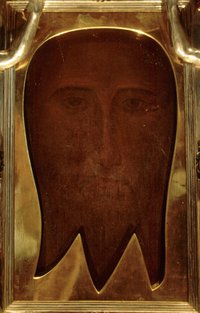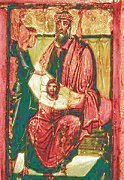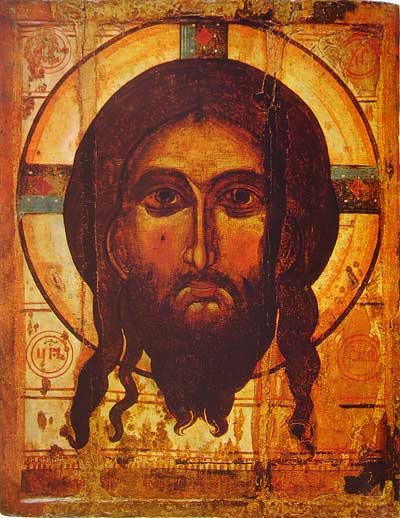The Story of the Mandylion Edessa
The striking photo is of The Mandylion of Edessa from the private chapel of
the pope in the Vatican.
What follows is the Wikipedia entry on The Mandylion. I apologize that it is not entirely adequate, lacking somewhat in detail and in tone. It will serve as a bare bones history, while I continue to research better sources. Dwayna
"The legend of the mandylion as it is known today is the product of centuries of development. The first and earliest version involves a letter written by King Abgar of Edessa to Jesus, asking him to come cure him of an illness. It is found in the History of the Church (1.13.5-1.13.22) written by Eusebius of Caesarea who claimed that he had transcribed and translated the actual letter in the Syriac chancery documents of the king of Edessa. In this earliest account, Christ replies by letter, saying that when he had completed his earthly mission and ascended, he would send a disciple to heal Abgar (and does so). It is noteworthy that in this first account there is no mention of an image of Jesus. That was a later addition to the story.
In AD 384, a pilgrim from a convent in the Far West, Egeria, was given a personal tour by the Bishop of Edessa, who gave her many marvellous accounts of miracles that had saved Edessa from the Persians and put into her hands transcripts of the correspondence of Abgarus and Jesus, with embellishments. Part of her accounts of her travels, in letters to her sisterhood, survive. "She naïvely supposed that this version was more complete than the shorter letter which she had read in a translation at home, presumably one brought back to the Far West by an earlier pilgrim." Her escorted tour, accompanied by a translator, was thorough; the bishop is quoted: "Now let us go to the gate where the messenger Ananias came in with the letter of which I have been telling you."(Palmer). There was no mention of an image reported by Egeria, who spent three days inspecting every corner of Edessa and the environs.
The next stage of development appears in the Doctrine of Addai [Thaddeus], c. 400, which introduces a court painter among a delegation sent by Abgar to Jesus, who paints a portrait of Jesus to take back to his master:
- When Hannan, the keeper of the archives, saw that Jesus spoke thus to him, by virtue of being the king's painter, he took and painted a likeness of Jesus with choice paints, and brought with him to Abgar the king, his master. And when Abgar the king saw the likeness, he received it with great joy, and placed it with great honor in one of his palatial houses. (Addai 13)
By 544, when the court historian Procopius recorded the recovery of Edessa from the Persians, he attributed the event to the letter sent from Jesus to Abgar. Yet in 593 Evagrius attributed the same event to a miraculous "God-made image," a miraculous imprint of the face of Jesus upon a cloth. It was this last and latest stage of the legend that became accepted in Eastern Orthodoxy and was mistakenly regarded as historical.
Thus we can trace the development of the legend from a letter, but no image in Eusebius, to an image painted by a court painter in Addai; then to a miracle caused by the letter in Procopius, which becomes a miracle caused by a miraculously-created image supernaturally made when Jesus pressed a cloth to his wet face in Evagrius.
The later legend of the image recounts that because the successors of Abgar reverted to paganism, the bishop placed the miraculous image inside a wall, and setting a burning lamp before the image, he sealed them up behind a tile; that the image was later found again, after a vision, on the very night of the Persian invasion, and that not only had it miraculously reproduced itself on the tile, but the same lamp was still burning before it; further, that the bishop of Edessa used a fire into which oil flowing from the image was poured to destroy the Persians.
This long-developing legend of a miraculous first image of Jesus that appeared on a cloth he pressed to his wet face, was adopted by the Eastern Orthodox church not as legend, but as historical fact. Countless reproductions of what was considered to be the image were painted as icons; in the 19th century many reproductions were carried by the Russian armies of Tsar Nicholas II. Because the miraculous image of the later legend was believed to be not made by humans but by God, it is called acheiropoietos in Greek -- "Not Made by Hands."
John of Damascus (died 749) mentions the image in his anti-iconoclastic work On Holy Images [1], quoting a tradition that Abgarus had requested an image of Jesus and Jesus himself put a cloth to his face to produce the image. The cloth is described as being a "strip", or oblong cloth, rather than a square, as other accounts hold.
The Mandylion disappeared again after the Persians conquered Edessa in 609. An Arab legend, related to historian Andrew Palmer when he visited Urfa (Edessa) in 1999, relates that the towel (mendil) of Jesus was thrown into a well in what is today the city's Great Mosque. The Christian tradition is at variance with this, recounting how in 944 it was exchanged for a group of Muslim prisoners — at that time the Image of Edessa was taken to Constantinople where it was received amidst great celebration by emperor Romanus I, who deposited it in the Palatine Chapel. It remained there until the Crusaders sacked the city in 1204 and carried off many of its treasures to western Europe - though the "Image of Edessa" is not mentioned in this context in any contemporary document.
Other documents from the 6th century— it is said— in the Vatican Library and the University of Leiden, Netherlands, seem to suggest another image at Edessa. A 10th century codex, Codex Vossianus Latinus Q 69 found by Gino Zaninotto in the Vatican Library contains an 8th-century account saying that an imprint of Christ's whole body was left on a canvas kept in a church in Edessa: it quotes a man called Smera in Constantinople: "King Abgar received a cloth on which one can see not only a face but the whole body" (in Latin: Faciei figuram sed totius corporis figuram cernere poteris)1. This image is apparently not the same as the mandylion whose widely-disseminated and familiar iconic image is of a face alone.
However, some modern researchers have suggested that by folding the Shroud of Turin it is possible to display a rectangle of fabric showing only the face, suggesting that the Shroud and the Mandylion are in fact one and the same relic. This interpretation is also a means of extending the provenance of the Shroud - of which no record exists before the fourteenth century."*
*Wikipedia entry on the Mandylion
 Abgar
with the image of Edessa
Abgar
with the image of Edessa
 The
Vernicle, The Mandylion
The
Vernicle, The Mandylion
The Tretyakov Gallery, Moscow, Russia
Novgorod school